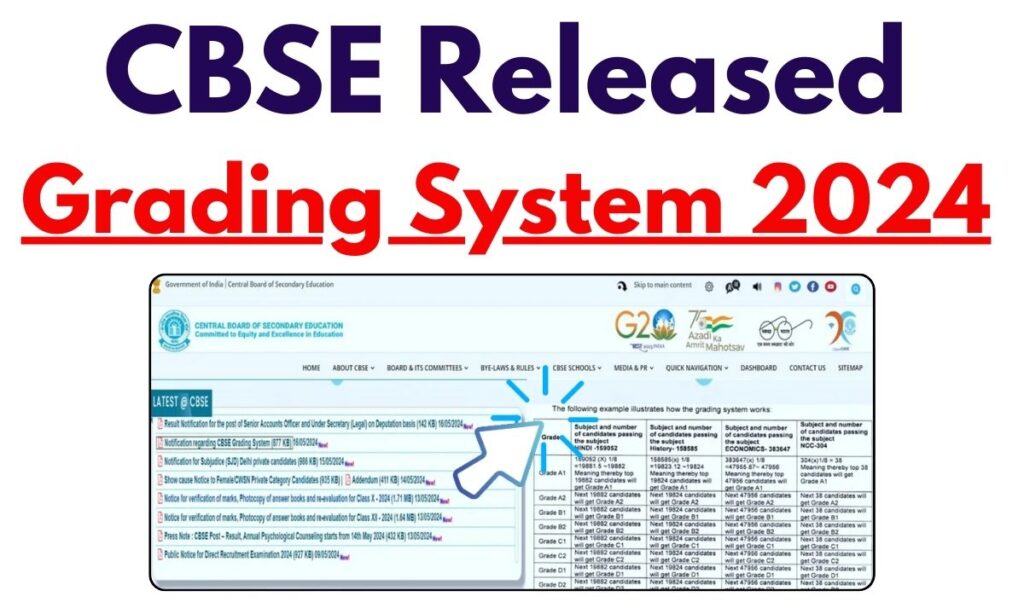CBSE Grading System 2024: On May 16, 2024, the Central Board of Secondary Education (CBSE) issued a notification reiterating the adoption of the ‘Relative Grading’ system for awarding subject-wise grades to students in classes X and XII. This CBSE Grading System 2024, previously detailed in a circular dated February 25, 2021, continues to reflect a significant shift from traditional absolute grading methods to a more nuanced and scientific approach. This article “CBSE Grading System 2024” delves into the intricacies of the CBSE Relative Grading system, elucidating its methodology, implementation, and implications for students and educators alike.
Under the CBSE Class 10 & 12 Grading System 2024, Relative Grading is a new way of grading students that compares their performance to their peers, rather than using fixed cut-off marks. This means that grades are based on how well a student did compared to others in the same group, rather than a fixed percentage or score. This approach helps to level the playing field, as it takes into account the difficulty of the exam or subject and ensures that students are judged fairly, regardless of the challenges they face. It’s like a bell curve, where the top performers get the highest grades, and the grades are distributed accordingly. If we compare it with the traditional grading system of CBSE when it earlier provided an A1 grade to all the students who achieved marks between 91 to 100 which is not 100% fair for toppers students. This way, students are rewarded for their hard work and talent, and the CBSE Grading System 2024 process is more fair and accurate.
How the CBSE Grading System 2024 Works?
Under the Relative Grading system, students’ grades are determined based on their rank within the group of passed candidates in each subject. The students are divided into eight equal groups, each representing one-eighth of the total number of passed candidates. The grades are then assigned as follows:
- – A-1: Top 1/8th of the passed candidates
- – A-2: Next 1/8th of the passed candidates
- – B-1: Next 1/8th of the passed candidates
- – B-2: Next 1/8th of the passed candidates
- – C-1: Next 1/8th of the passed candidates
- – C-2: Next 1/8th of the passed candidates
- – D-1: Next 1/8th of the passed candidates
- – D-2: Next 1/8th of the passed candidates
- – E: Essential Repeat

CBSE UAE GRADING SYSTEM 2024 with example
If you are still confused about the calculation of toppers and marks according to the CBSE new relative grading system then you can check the following example. If we select Hindi as an example subject and assume that a total of 1 lakh students passed the Hindi subject in the 10th class then we will divide it with ⅛. After that, we will get the number 12500. The relative grading system will award the A1 grade to the first 12500 students in this list and after that next 12500 students will be included in the A2 grade. After that, it will follow till the grade D.
7th Pay Commission New Update 2024: DA 50% इज़ाफ़ा होते ही इन भत्तों में रिकॉर्ड तोड़ इजाफा
300 से कम सिबिल स्कोर – 7 लाख का लोन, यहां से मिलेगा: Low Cibil Score Loan Apps
CRCS Sahara Refund Portal: ब्याज सहित पैसा वापस, सहारा रिफंड के लिए अभी करें अप्लाई, नया पोर्टल लांच
Key Considerations in Implementing Relative Grading System CBSE
Adjusting for Ties: In the case of students achieving identical scores, the system allows for minor variations in the proportion of candidates to adjust ties. This ensures that no student is unfairly disadvantaged by the clustering of scores at specific marks. If a tie occurs, all students with the same score receive the same grade, maintaining fairness and consistency.
Applicability by Subject Size: The Relative Grading method is applied in subjects where more than 500 candidates have passed. This threshold ensures that the grading system has a sufficiently large sample size to effectively distribute students into the eight groups. For subjects with fewer than 500 candidates, the grading pattern follows that of other similar subjects to maintain consistency across different subjects and sessions.
Advantages of the Grading system of CBSE//CLASS – 10TH & 12TH
One of the primary benefits of Relative Grading is its ability to level the playing field. By evaluating students relative to their peers, the system accounts for variations in exam difficulty and ensures that a student’s grade is reflective of their performance in the context of the cohort’s overall achievement.
Relative Grading can alleviate some of the pressure associated with achieving high absolute scores. Students are encouraged to focus on understanding and mastering the subject matter rather than aiming for specific marks. This shift in focus can foster a more holistic educational experience.
Flexibility in Evaluation: The system’s ability to adjust for ties and apply to various subject sizes demonstrates its flexibility. This adaptability ensures that the grading system remains robust and fair across different subjects and examination sessions.

